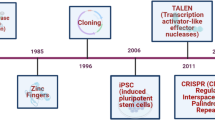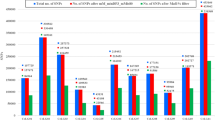Abstract
Molecular marker-assisted selection is a better way to satisfy the growing customer requirement with the development of beef cattle growth and breeding research. For now, quantitative trait locus (QTL) for cattle growth and carcass traits, just like body height, body length and carcass weight have been detected on bovine chromosome 6. In this study, ligand-dependent nuclear receptor corepressor-like (LCORL) was selected as the potential positional candidate gene located in chromosome 6 which is closely connected with the bovine growth and carcass traits. A total of 450 Qinchuan beef cattle were used to detect mutations in exon and its neighbouring region, and the promoter region of the bovine LCORL gene. The methods for SNPs detection were polymerase chain reaction-restriction fragment length polymorphism (PCR-RFLP) and created restriction site PCR (CRS-PCR), and the results of this study show that there were two variations in intron regions, the other four variations were located in the promoter region. Linkage disequilibrium analysis and haplotype analysis indicated that L78-Q4 had strong linkage disequilibrium, A T G C G C (16.2%) and G C G C A T (16.7%) had higher haplotype frequencies, G C A C A C (0.8%) and G T A C A T (0.7%) had lower haplotype frequencies. Correlation analysis indicated that SNP g. INT + 52098A >G was significantly associated with slaughter weight and carcass weight. Based on the research, we selected LCORL as the candidate gene that can contribute to improved marker-assisted selection for the meat performance of Qinchuan beef cattle.



Similar content being viewed by others
References
Barrett J. E., Fry B., Maller J. and Daly M. J. 2005 HAPLOVIEW: analysis and visualization of LD and haplotype maps. Bioinformatics 21, 263–265.
Bongiorni S., Mancini G., Chillemi G., Pariset L. and Valentini A. 2012 Identification of a short region on chromosome 6 affecting direct calving ease in Piedmontese cattle breed. PLoS One 7, e50137.
Boyko A. R., Brooks S. A., Behan-Braman A., Castelhano M., Corey E., Oliveira K. C. et al. 2014 Genomic analysis establishes correlation between growth and laryngeal neuropathy in thoroughbreds. BMC Genomics 15, 259.
Carty C. L., Johnson N. A., Hutter C. M., Reiner A. P., Peters U., Tang H. et al. 2012 Genomewide association study of body height in African Americans: the women’s health initiative SNP health association resource (SHARe). Hum. Mol. Genet. 21, 711–720.
Cheong H., Yoon D. H., Kim L., Park B. L., Choi Y. H., Chung E. R. et al. 2006 Growth hormone-releasing hormone (GHRH) polymorphisms associated with carcass traits of meat in Korean cattle. BMC Genet. 7, 35.
Dorman K., Shen Z., Yang C., Ezzat S. and Asa S. L. 2012 CtBP1 interacts with Ikaros and modulates pituitary tumor cell survival and response to hypoxia. Mol. Endocrinol. 26, 447–457.
Falconer D. S., Mackay T. F. and Frankham R. 1996 Introduction to quantitative genetics. (4th edn). Trends in Genetics 12, 280.
Gao Y. and Zhang J. B. 2011 Association of A-FABP gene polymorphismin intron 1 with meat quality traits in Junmu no. 1 white swine. Gene 487, 170–173.
Gärtner K. 2012 A third component causing random variability beside environment and genotype. A reason for the limited success of a 30 year long effort to standardize laboratory animals? Lab. Anim. 24, 71–77.
Greenwood T. A. and Kelsoe J. R. 2003 Promoter and intronic variants affect the transcriptional regulation of the human dopamine transporter gene. Genomics 82, 511–520.
He S., Zhang L., Li W. and Liu M. 2015 BIEC2-808543 SNP in the LCORL gene is associated with body conformation in the Yili horse. Anim. Biotechnol. 26, 289–291.
Ibeagha-Awemu E. M., Kgwatalala P. and Zhao X. 2008 A critical analysis of production-associated DNA polymorphisms in the genes of cattle, goat, sheep, and pig. Mamm. Genome 19, 591–617.
Kijas J. W. 2014 Haplotype-based analysis of selective sweeps in sheep. Genome 57, 433–437.
Kim W., Bennett E. J., Huttlin E. L., Guo A., Li J., Possemato A. et al. 2011 Systematic and quantitative assessment of the ubiquitin-modified proteome. Mol. Cell 44, 325–340.
Kimura Y. and Tanaka K. 2010 Regulatory mechanisms involved in the control of ubiquitin homeostasis. J. Biochem. 147, 793–798.
Konfortov B. A., Licence V. E. and Miller J. R. 1999 Re-sequencing of DNA from a diverse panel of cattle reveals a high level of polymorphism in both intron and exon. Mamm. Genome 10, 1142–1145.
Lie R., Sun T., Zhao G., Wang F., Wu D., Zheng M. et al. 2013 Genome-wide association study identified loci and candidate genes for body composition and meat quality traits in Beijing-You chickens. PLoS One 8, e61172.
Lindholm-Perry A. K., Sexten A. K., Kuehn L. A., Smith T. P., King D. A., Shackelford S. D. et al. 2011 Association, effects and validation of polymorphisms within the NCAPG-LCORL locus located on BTA6 with feed intake, gain, meat and carcass traits in beef cattle. BMC Genet. 12, 103.
Lindholm-Perry A. K., Kuehn L. A., Oliver W. T., Sexten A. K., Miles J. R., Rempel L. A. et al. 2013 Adipose and muscle tissue gene expression of two genes (NCAPG and LCORL) located in a chromosomal region associated with cattle feed intake and gain. PLoS One 8, e80882.
Liu R. R., Sun Y. F., Zhao G. P., Wang H. Y., Zheng M. Q., Liu L. et al. 2015. Identification of loci and genes for growth related traits from a genome-wide association study in a slow- × fast-growing broiler chicken cross. Genes Genome, doi:10.1007/s13258-015-0314-1.
Mačeková S., Bernasovský I., Gabriková D., Bôžiková A., Bernasovská J., Boroňová I. et al. 2012 Association of the FTO rs9939609 polymorphism with obesity in Roma/Gypsy population. Am. J. Phys. Anthropol. 147, 30–34.
Mancini G., Gargani M., Chillemi G., Nicolazzi E. L., Marsan P. A., Valentini A. et al. 2014 Signatures of 641 selection in five Italian cattle breeds detected by a 54K SNP panel. Mol. Biol. Rep. 41, 957–965.
McClure M. C., Morsci N. S., Schnabel R. D., Kim J. W., Yao P., Rolf M. M. et al. 2010 A genome scan for quantitative trait loci influencing carcass, post-natal growth and reproductive traits in commercial Angus cattle. Anim. Genet. 41, 597–607.
Msalya G., Shimogiri T., Nishitani K., Okamoto S., Kawabe K. and Minesawa M. 2010 Indels within promoter and intron 1 of bovine prion protein gene modulate the gene expression levels in the medulla oblongata of two Japanese cattle breeds. Anim. Genet. 41, 218–221.
Nkrumah J. D., Sherman E. L., Li C., Marques E., Crews D. H., Bartusiak R. et al. 2007 Primary genome scan to identify putative quantitative trait loci for feedlot growth rate, feed intake, and feed efficiency of beef cattle. J. Anim. Sci. 85, 3170– 3181.
Pryce J. E., Hayes B. J., Bolormaa S. and Goddard M. E. 2011 Polymorphic regions affecting human height also control stature in cattle. Genetics 187, 981–984.
Randhawa I. A., Khatkar M. S., Thomson P. C. and Raadsma H. W. 2015 Composite selection signals for complex traits exemplified through bovine stature using multi-breed cohorts of European and African Bos taurus. G3 (Bethesda) 5, 1391– 1401.
Rubin C. J., Megens H. J., Martinez Barrio A., Maqbool K., Sayyab S., Schwochow D. et al. 2012 Strong signatures of selection in the domestic pig genome. Proc. Natl. Acad. Sci. USA 109, 19529–19536.
Sahana G., Höglund J. K., Guldbrandtsen B. and Lund M. S. 2015. Loci associated with adult stature also affect calf birth survival in cattle. BMC Genet. (doi:10.1186/s12863-015-0202-3).
Sambrook J., Maccallum P. and Russel D. 2001 Molecular cloning: a laboratory manual, 3rd edition, p. 2344. Cold Springs Harbour Press, New York, USA.
Short T. H., Rothschild M. F., Southwood O. I., McLaren D. G., De Vries A. and Van der Steen H. 1997 Effect of the estrogen receptor locus on reproduction and production traits in four commercial pig lines. J. Anim. Sci. 75, 3138–3142.
Signer-Hasler H., Flury C., Haase B., Burger D., Simianer H., Leeb T. et al. 2012 A genome-wide association study reveals loci influencing height and other conformation traits in horses. PLoS One 7, e37282.
Snabboon T., Plengpanich W., Buranasupkajorn P., Khwanjaipanich R., Vasinanukorn P., Suwanwalaikorn S. et al. 2008 A novel germline mutation, IVS4 + 1GNA, of the POU1F1 gene underlying combined pituitary hormone deficiency. Horm. Res. 69, 60–64.
Sovio U., Bennett A. J., Millwood I. Y., Molitor J., O’Reilly P. F., Timpson N. J. et al. 2009 Genetic determinants of height growth assessed longitudinally from infancy to adulthood in the northern Finland birth cohort 1966. PLoS Genet. 5, e1000409.
Tetens J., Widmann P., Kühn C. and Thaller G. 2013 A genome-wide association study indicates LCORL/NCAPG as a candidate locus for withers height in German Warmblood horses. Anim. Genet. 44, 467–471.
Vaysse A., Ratnakumar A., Derrien T., Axelsson E., Rosengren Pielberg G., Sigurdsson S. et al. 2011 Identification of genomic regions associated with phenotypic variation between dog breeds using selection mapping. PLoS Genet. 7, e1002316.
Vinayagam A., Stelzl U., Foulle R., Plassmann S., Zenkner M., Timm J. et al. 2011 A directed protein interaction network for investigating intracellular signal transduction. Sci. Signal. 4, rs8.
Weikard R., Altmaier E., Suhre K., Weinberger K. M., Hammon H. M., Albrecht E. et al. 2010 Metabolomic profiles indicate distinct physiological pathways affected by two loci with major divergent effect on Bos taurus growth and lipid deposition. Physiol. Genomics 42A, 79–88.
Wu G., Bazer F. W., Davis T. A., Kim S. W., Li P., Marc Rhoads J. et al. 2009 Arginine metabolism and nutrition in growth, health and disease. Amino Acids 37, 153–168.
Acknowledgements
This research was supported by the National Eleventh ‘Five-Year’ National Science and Technology Key Project (no. 2008AA101010), National Twelfth ‘Five-Year’ National Science and Technology Key Project (no. 2011AA100307), ‘13115’ Sci-Tech Innovation Programme of Shaanxi province (no. 2008ZDKG-11) and Sci-Tech Integrated Innovation Engineering Projects of Shaanxi province (no. S2015TLNY0017).
Author information
Authors and Affiliations
Corresponding author
Additional information
Corresponding editor: Silvia Garagna
[Han Y. J., Chen Y., Liu Y. and Liu X. L. 2017 Sequence variants of the LCORL gene and its association with growth and carcass traits in Qinchuan cattle in China. J. Genet. 96, xx–xx]
Rights and permissions
About this article
Cite this article
HAN, Y.J., CHEN, Y., LIU, Y. et al. Sequence variants of the LCORL gene and its association with growth and carcass traits in Qinchuan cattle in China. J Genet 96, 9–17 (2017). https://doi.org/10.1007/s12041-016-0732-0
Received:
Revised:
Accepted:
Published:
Issue Date:
DOI: https://doi.org/10.1007/s12041-016-0732-0




